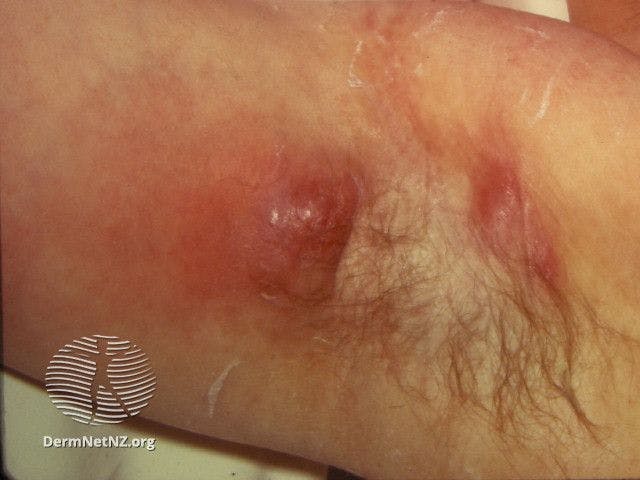- Acne
- Actinic Keratosis
- Aesthetics
- Alopecia
- Atopic Dermatitis
- Buy-and-Bill
- COVID-19
- Case-Based Roundtable
- Chronic Hand Eczema
- Chronic Spontaneous Urticaria
- Drug Watch
- Eczema
- General Dermatology
- Hidradenitis Suppurativa
- Melasma
- NP and PA
- Pediatric Dermatology
- Pigmentary Disorders
- Practice Management
- Precision Medicine and Biologics
- Prurigo Nodularis
- Psoriasis
- Psoriatic Arthritis
- Rare Disease
- Rosacea
- Skin Cancer
- Vitiligo
- Wound Care
News
Article
Dermatology Times
New AAD Atopic Dermatitis Guidelines and Dupilumab Label Updates
Author(s):
Five experts delved into the latest updates to treatment guidelines and the updated label use for dupilumab for hand-foot AD.

The 2024 Masterclasses in Dermatology Conference in Puerto Rico welcomed numerous experts in multidisciplinary care to spotlight dermatologic considerations in a wide range of patient populations and conditions. Dermatology Times had the opportunity to catch up with 5 experts in atopic dermatitis (AD) treatment for the custom Expert Perspectives video series “Advancements in Atopic Dermatitis: Insights From the 2024 Masterclasses in Dermatology Conference.” They delved into the latest updates to the American Academy of Dermatology (AAD) AD guidelines and the updated label use for dupilumab (Dupixent) for hand-foot AD.
The AAD updated its guidelines for the first time since 2014 with recommendations for AD management in patients who do not respond to topical therapies. After their comprehensive review, the academy recommended the use of dupilumab, tralokinumab (Adbry), baricitinib (Olumiant), abrocitinib (Cibinqo), and upadacitinib (Rinvoq); conditionally recommend phototherapy, cyclosporine, methotrexate, azathioprine, and mycophenolate; and do not recommend systemic corticosteroids.1
Additionally, earlier this year the FDA approved an update to the label for dupilumab in AD, specifically addressing patients aged 12 years and older with uncontrolled moderate to severe hand and/or foot involvement. The label update is based on findings from the phase 3 LIBERTY-AD-HAFT trial (NCT04417894), a double-blind, placebo-controlled study involving 133 adult and adolescent patients with AD and moderate to severe hand and/or foot involvement.2
Updates in Guidelines
Raj Chovatiya, MD, PhD, shared insights on the long-awaited update of guidelines for AD. “With so much new data and therapeutics, we have something to point to at any time,” he stated. Chovatiya emphasized the practical guidance offered by the updated guidelines, particularly in addressing access barriers and facilitating shared decision-making between health care providers and patients.
Chovatiya said, “[Patients] may be interested in something that’s going to work extremely quickly. They might be interested in something that they can use every day or maybe don’t have to use every day... Maybe it’s long-term data that really resonate with them. Maybe it’s just the cleanest possible safety profile with no chance anything is going to go wrong. I think those are really the factors that help to dictate what might be the right therapeutic choice.”
Understanding Patient Challenges
In assessing patients with hand-foot AD, Susan Taylor, MD, emphasized the profound challenges they face. “Many patients are unable to use their hands. It’s just too painful. They’re dry. They’re cracked,” she said. Taylor underscored the importance of evaluating patients’ ability to perform daily activities, such as grasping objects and walking long distances. She stressed the critical need to restore hand function, particularly for individuals engaged in manual labor, emphasizing the introduction of dupilumab and the potential benefits for patients with hand or foot involvement.
Taylor also acknowledged the ongoing need for more diversity in clinical trials. “It’s wonderful to see that we have real data and practical guidance,” she said. “We still need more representation, particularly among certain disease states.”
Efficacy in Treatment
Peter Lio, MD, explained the importance of efficacy in treating AD affecting the hands and feet. “In terms of the efficacy and how I interpret the findings [of the LIBERTY-AD-HAFT trial], I think we’ve known for a long time that all body locations of eczema are not equal, right? So if you say somebody has 5% body surface area [BSA], 10% BSA, it matters a lot where that is. The hands and feet are particularly important. They might not be a huge percentage, but they can affect every aspect of life when you’re shaking hands, when you’re using computers, when you’re using tools, all of those things,” he said.
Lio also stressed the importance of individualized treatment approaches, considering patient preferences and safety monitoring.
Tailored Treatment Approaches
Brad Glick, DO, MPH, highlighted the evolving landscape of AD treatment and the importance of tailored approaches. He emphasized the need to consider patient demographics and preferences. “Factors such as occupation, travel frequency, and extracurricular activities are weighed against therapy modalities,” Glick said. He advocated for collaborative patient education and personalized treatment plans, underscoring the significance of patient-centered care.
Shared Decision-Making
David Rosmarin, MD, also emphasized the pivotal role of shared decision-making in dermatology treatment. “When discussing treatment options, it’s essential to consider patient preferences and circumstances,” he said. Rosmarin concluded with a reflection on challenging cases and explained, “In complex cases, it’s essential to listen to patients and adjust treatment strategies accordingly.”
References
1. Davis DMR, Drucker AM, Alikhan A, et al. Guidelines of care for the management of atopic dermatitis in adults with phototherapy and systemic therapies. J Am Acad Dermatol. 2024;90(2):e43-e56. doi:10.1016/j.jaad.2023.08.102
2. Andrus E. FDA updates dupilumab label with hand, foot atopic dermatitis involvement. Dermatology Times. January 16, 2024. Accessed March 18, 2024. https://www.dermatologytimes.com/view/fda-updates-dupilumab-label-with-hand-foot-atopic-dermatitis-involvement

Newsletter
Like what you’re reading? Subscribe to Dermatology Times for weekly updates on therapies, innovations, and real-world practice tips.


























